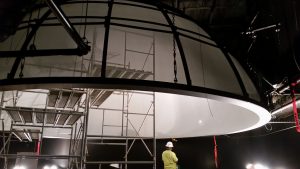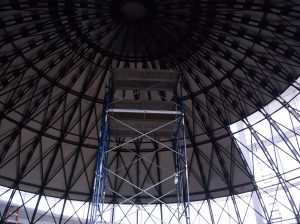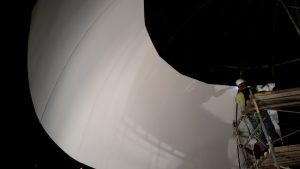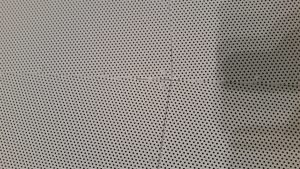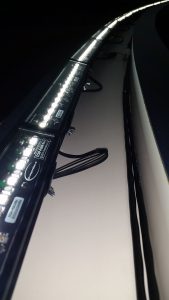Domed Screens
An essential part of the complete planetarium theater, is the domed screen. This is the surface upon which all imagery is projected, and it can play a vital role in promoting the immersive experience for the audience. We work with your project team and top dome suppliers to provide the best options for your venue, intention, and budget. We work with your architectural team to guide you through tricky aspects of the project that you may not have considered, and can recommend orders of operation on new projects, making the overall installation run much more smoothly and help stay on track.
When considering a dome, here are a few factors that you should consider:
Size
The size of the dome affects much more than seating capacity and overall cost. When considering the size of the dome, it is important to understand that as the dome size changes, the recommended projection technology may also change. This is due to important bits of physics, like the inverse square law, as the same amount of light in a small projection system may not be enough when spread across the larger surface area of a bigger dome. The cost associated with a dome can sometimes be linked to whether the manufacturer has already done the engineering and tooling for a dome of a popular size compared to one that is custom.
Tilt
Modern planetariums have been taking design concepts from other domed venues, sometimes without asking about whether it works as a concept or is the best approach. Tilting a dome or theater is one of those concepts worth taking a hard look at whether the value is worth the additional hassle. Here are a few things to consider:
- Star Projectors – such as the ZKP4 use gravity shutters to mask at an artificial horizon to block the light from hitting the audience. Such shutters do not function to the tilt of a dome, but are possible with more expensive projectors designed for larger venues. It is also tough to accurately represent the night sky if you are showing a sky that dips below the horizon on one side, and completely hides the North Star on the other side of the theater.
- Safety & Darkness – As soon as you tilt a theater enough to require steps and handrails, you start to introduce a need for lighting and remove any possibility of achieving a dark environment to simulate the night sky. Domes are then illuminated, so instead of a dark sky, it becomes a washed out grey sky and the audience is no longer immersed. Sometimes handrails can also get in the way of projection path, making it tough to configure a clear view for the audience or may cast shadows from the handrails. Yes, this has happened (not our project) and the results are less than favorable.
- Audience Comfort – While the view of the dome may be better for shows which are conversions from large-format films, some people experience discomfort in entering, climbing and navigating a tilted theater. The more extreme the tilt, the greater the difficulty is.
- Mixed Use – With a flat dome, it is easier to have removable seats to set up cocktail events and other non-traditional theater uses. Depending on the venue and expected use, tilting a theater can greatly impact the viability of such activities.
- Cost – Sometimes the cost of the dome might increase by roughly 10% or more just by wanting some tilt, not counting any custom engineering required.
Seams
One of the biggest cost-dependent variations in domed screen technology is around the process by which the panels are joined together on the frame, how they overlap, and what the results are when viewed under projection. There are usually three main variations when it comes to panel overlap. The named levels of quality are basic and not necessarily reflecting any particular company branding.
- Standard – no special effort is made to hide the seams, they overlap in some way and will not be seen if the projected imagery is the night sky, as this is very forgiving.
- Premium – Some effort is taken to hide the seams, whether by altering the method, angle, or direction of overlap. This is usually an increased cost based around extra labor and time required.
- Hidden – While certainly visible under some situations, the intention is to hide the seams as best as possible. This may be done by precision abutment, or special crimped and cut overlap techniques. There is often a considerable increase in labor and time required, adding to a much hire cost.
Reflectivity and Paint
One vendor claims powder coating of panels is better, while the other claims painting on-site is better…which is it? Both have valid points and we will share that lively discussion when the time comes, as it may affect long-term processes such as potential for repainting after your roof eventually leaks. Perhaps a bigger concern, is the reflectivity of the dome. This is referred to as other terms such as the screen brightness, whiteness, gain, or albedo, and is often listed as a numerical value such as .48 or 65%. Here is why it maters…
- Classic Planetariums – With traditional star projectors, the weak lamps and photo-based star plates preferred a higher gain dome so that the stars appeared brighter. With modern ZEISS stars from LED illuminated, fiber optically fed stars, the gain of the dome is much more flexible.
- Fulldome Digital Video – The biggest concern is related to contrast of the projectors and cross-bounce reflections on the dome. These two concepts are often purposefully confused to convince consumers that lower quality projection is just as good, but the two are not interchangeable. It is easy to understand that motivation when someone only has lower contrast projectors to offer.
- Contrast – The black level of the projector in terms of relativity to the brightness. This is a static value that doesn’t change, although some projectors utilize shutters or other technology to hide the grey when only projecting black. A standard DLP projector may only have 2,000:1 native contrast, while the VELVET boasts an impressive 2,500,000:1 native contrast. With a darker background surface to project on, the grey of the lower contrast projector can be hidden better than it would on a high-gain dome.
- Cross-bounce – the reflection of an image from one side of the dome to another. This is the effect of how bright the background gets when a bright image like a full moon is displayed on an otherwise dark dome. There are some factors such as hemispherical angle and projector placement that can play a role here, but it is a temporary effect that is seen under specific circumstances. Take away the bright image, and the overall black levels return to normal.
Cove Space
In the olden days of planetariums, there was a trough for lighting that was separate from the dome, and a gallery space below the dome where slide projectors, special effects, and other devices were hidden around the perimeter yet allowed a clear path to the dome. In a modern planetarium dome, the lighting cove is usually smaller and attached to the base of the dome. Extending inward anywhere from 3″ to 12″, the space no longer needs to be used for home-grown special effects, but simply big enough to hide the lighting. Just because the old dome had a deep cove separate doesn’t mean the new one should. We will help you determine the right cove for the lighting selected for your venue based on your needs, the reflectivity of the dome, and other project specific factors. We talk more about LED lighting in the accessories section, but will also use the cove info to determine bracketing and attachment methods for the lighting system.
